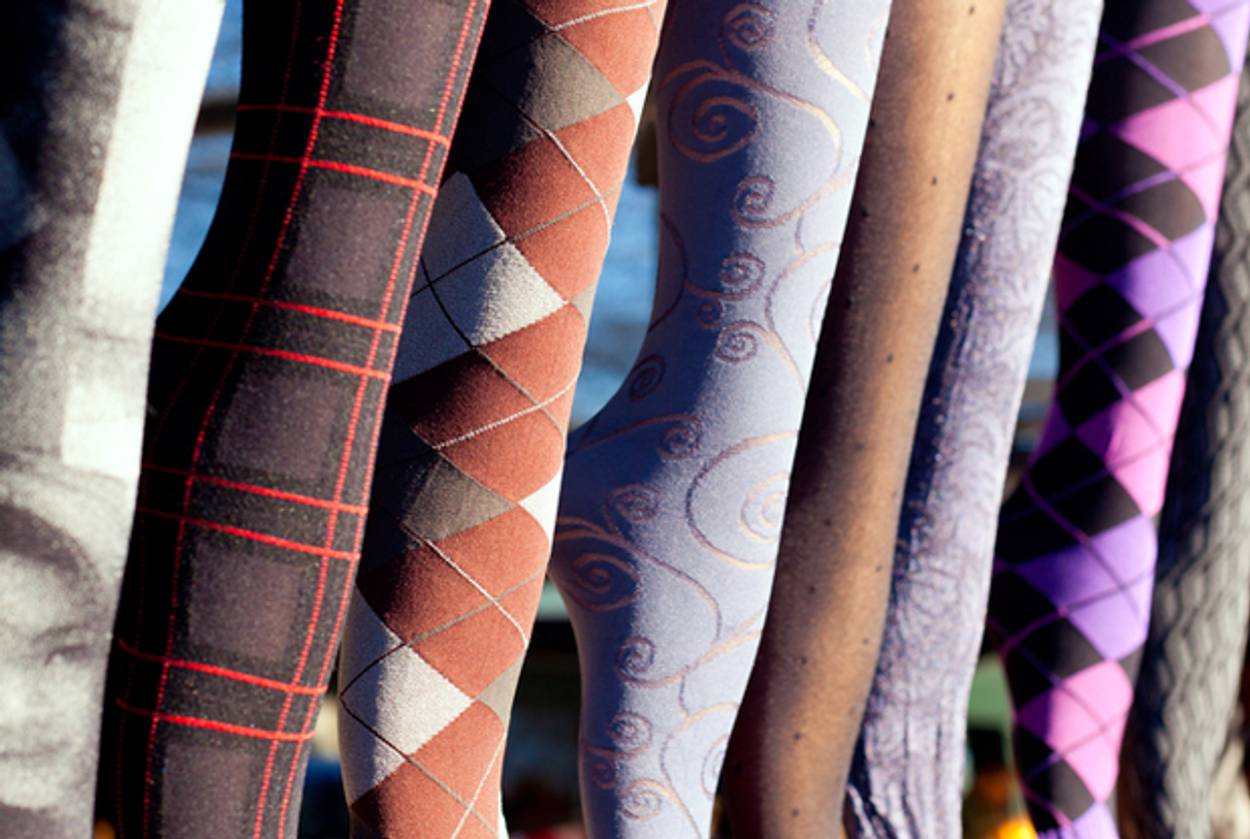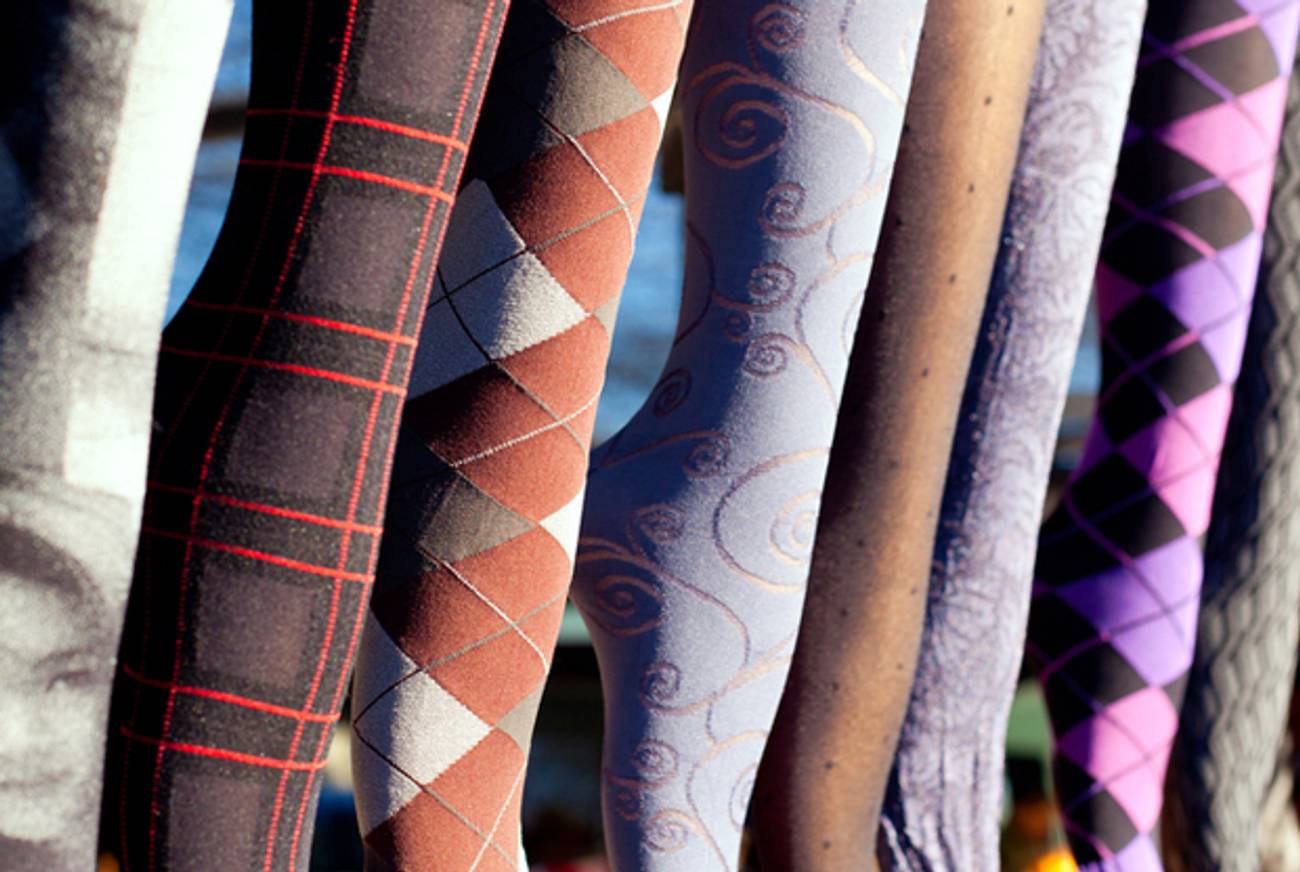Festival of Tights
Orthodox Jewish women of all stripes flock to an annual holiday sample sale




Hundreds of boxes piled high with tights of all colors, patterns, and materials, as well as pantyhose, leggings, trouser socks, boot liners, jeggings, and kids tights created a labyrinth that snaked in and out of several rooms on the 10th floor of a 34th street office building in Manhattan. This week is wholesaler Leg Resource’s annual Holiday Sample Sale, and a number of Orthodox Jewish women crowded the maze of brown boxes. For these women, tights are an important part of life—some wear tights as part of their daily wardrobe, winter and summer alike—and they are some of Leg Resource’s most valuable customers.
One of Leg Resource’s owners, who declined to be named but who everyone called Wayne, stood at the front of the long check-out line counting tights. At the end of each tabulation, he grabbed an extra pair of socks, dropped them into the bag, and said, “Free!” He told me they’ve been doing the sale for 18 years, and that they specifically target Orthodox women through their schools. He introduced me to Julia Siegel, who he called a “very entrepreneurial girl,” who manages the sale’s Stern College advertising in exchange for free tights.
“The sale sells itself with Stern,” Siegel told me. “You even have professors who talk about it. There’s one teacher, literally on the first day of every class she tells her students, ‘By the way, there’s a tights sale, you need to put down the date.’ She loves it. She tells everyone, ‘Don’t take my size, don’t take my style, but you should go.’” Advertising the sale involves hanging posters throughout the Stern building and the dorms, making a Facebook event, and telling her friends.
Word travels quickly, Siegel says. On the Facebook group, over one 1,000 women were invited, and 300 RSVP’d yes, though far more ended up attending, representing a broad cross-section of Orthodox Judaism.
I met Tamar Katz as she was entering the sale. Katz lives in Flatbush, and defines herself as “Mainstream Orthodox,” which she distinguished from other strains of Orthodoxy as being more open-minded. She was wearing a grey knit beret over a fall, or half wig; “This is mine,” she said, pointing to the inch of hair above her forehead peeking out of her hat; “This is not,” she added, pointing to the long, auburn mane that hung down her back. She was wearing a grey denim knee-length skirt and dangling turquoise earrings. She wears tights in the winter, but not always in the summer.
Leonora Ashkenazi, another woman I met at the sale, also lives in Flatbush. Ashkenazi had long black hair and was wearing taupe colored booties and no tights. She defined herself as “Sephardic Orthodox Modern.” When asked what distinguishes her brand of Orthodoxy, she said she doesn’t like to judge people based on what they do.
Another woman who identified herself as Rachel wouldn’t say where she lives. When asked about her religious practice, she said she doesn’t like labels, but defined herself as “very committed.” Rachel, who is in medical school, was wearing a long, heavy, dark blond wig. “I dress modestly,” she said of her dress code. “Different people have different interpretations of the laws,” she explained. Rachel also doesn’t always wear tights.
I met a young woman named Mushky, who’s from Paris but is studying in Crown Heights, in the check-out line. She found out about the sale through a WhatsApp text message group. When I asked her how she defines her religious observance, she said, “What do you mean? Fun. Meaningful.” When I clarified, she told me she was Chabad or Lubavich. Mushky wears stockings or tights every day, even in the summer. “That’s why it’s exciting, I get a lot now,” she said about the sale. I asked her to define the characteristics of the Chabad clothing style: “We try not to be too fitted. We try to focus on our inside, not our outside.”
Also checking out were Rachelli Ramras and Aliza Gottlieb. They both live in Teaneck, N.J., and identify as Modern Orthodox, which they explained meant “living in modern society and integrating that with our religious life. Making society fit in with our religious ideals. Living life by Orthodox values and following Halacha and also engaging in the modern world.” They were both wearing knee-length flared skirts, black tights, and flat moccasin booties. They are students at Yeshiva University’s Stern College for Women, where Ramras is studying Economics and Math, and Gottlieb is studying Judaic Studies.
I asked if they would be able to spot an Orthodox woman across the street based on her outfit. They giggled and said yes. “What stands out most is the way that we dress,” said Ramras. “You could tell a Modern Orthodox girl from someone who’s not Jewish, but you can also tell a Modern Orthodox girl from an ultra-Orthodox person,” said Gottlieb. “If you see me, I’m wearing a skirt below my knees, and my neckline is high, and my sleeves are long, but I’m wearing the same brands that anyone is wearing, so I’m wearing clothing that I think is cool and trendy and in fashion, but also modest.” Both women only wear tights when it’s cold. They both did very well at the sale.
On the floor of one of the less crowded rooms sat a group of girls in a uniform of pleated forest green skirts, white blouses, and navy sweaters. They were sorting their tights in order of desirability. One of the girls, Mussie, had freckles and trendy round, blue glasses. She told me they went to a Chabad school in Crown Heights, and had heard about the sale through friends. I asked how one could identify a Chabad girl on the street. “Classy, well-dressed, more colors,” she said, as opposed to other Hasidic sects whose members often limit themselves to black. “It’s very important to be pretty and modest,” she explained, “but it’s also a value that women should be put together.”
Noticeably absent were the Satmar women, whose preferred legwear, “Palm” stockings, is manufactured in-house within the community, and was designed under the guidance of their previous spiritual leader, Rabbi Joel Teitelbaum (Teitelbaum means palm in German). These stockings are manufactured by the Satmar and are not carried by Leg Resource, though when I mentioned them over the phone, a woman who worked there sounded very interested.
Leg Resource’s owner estimated that 20 percent of their business comes from Orthodox women, but his associate, Ron Merrimen, estimated it to be closer to 60 percent. Merrimen took me to a corner of one of the large rooms, which was filled with at least 20 twenty boxes of identical black tights—the 60/40 Anne Klein. “They love this stuff,” Merrimen said, picking up a pair and stretching it tautly between his hands. “This is great quality stuff. It doesn’t get too hot, either. It’s our number one seller.”
He took me to a different room, where a few remaining boxes held lone pairs of tights. “This here is their hangout,” he said. “See?” He pointed to where a few girls in uniform were sorting through the boxes. “They come straight from school in their uniform. It makes them happy. It’s a good deal.”
He picked up a pair of leopard print tights and gave them a stretch. “This is just $2. That’s a nice pair of leggings.” I asked if he thought the Orthodox girls might buy such a pair. “Some of them!” he said.
Related: Tights Squeeze
Batya Ungar-Sargon is a freelance writer who lives in New York. Her Twitter feed is @bungarsargon.